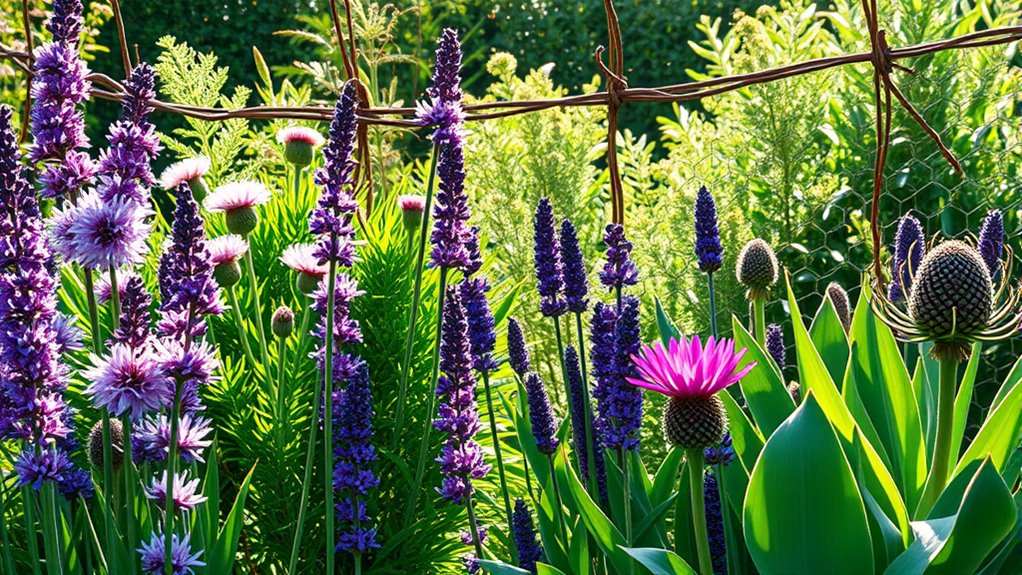To create a deer-proof garden that truly works in 2025, combine native, deer-resistant plants with sturdy, well-installed fencing—at least 8 feet tall—to prevent jumps. Reinforce fences at the bottom and consider electric options for added protection. Use native plants as buffers near barriers, along with natural deterrents like repellents or motion-activated devices. Maintaining these defenses guarantees your garden remains safe; more tips lie ahead to strengthen your deer-resistant landscape.
Key Takeaways
- Use native, deer-resistant plants like coneflowers and black-eyed Susans to create natural barriers and reduce attraction.
- Install at least 8-foot-tall, sturdy fencing with regular maintenance and reinforcement at the base to prevent deer entry.
- Combine physical fences with native plants and natural deterrents for a layered, more effective garden defense system.
- Reinforce fence bottoms with wire or landscaping rocks and consider electric fencing for added protection.
- Regularly inspect and maintain all barriers, and plan your garden to minimize deer attractants for lasting deer-proofing.

Creating a deer-proof garden requires careful planning and strategic plant choices. One of the most effective ways to deter deer is by selecting native plants that they tend to avoid. Native plants are naturally resistant to local pests and wildlife, including deer, because they have evolved alongside these animals. Incorporating these plants into your garden not only minimizes damage but also supports local ecosystems. Think about planting species like coneflowers, black-eyed Susans, or native grasses, which deer generally leave alone. These choices create a natural barrier that reduces the likelihood of deer munching on your garden beds.
In addition to choosing the right plants, fencing options play a vital role in protecting your garden. A sturdy, properly installed fence can be the first line of defense against deer intrusions. The most effective fencing options are typically at least 8 feet tall, as deer are capable jumpers and can clear lower barriers. You might consider woven wire fencing, which is durable and can be hidden behind plants or structures for aesthetic appeal. Alternatively, deer-proof mesh fences with small openings can prevent even the most persistent jumpers from entering. When installing fencing, ensure it’s securely anchored into the ground to prevent deer from crawling underneath or pushing through. Reinforcing the bottom with wire or landscaping rocks can further enhance its effectiveness. Some gardeners prefer electric fences that deliver a mild shock, which deer quickly learn to associate with the barrier, discouraging repeated attempts. Regardless of the fencing option you choose, maintenance is key—regularly inspect for damage or gaps that could give deer access to your garden.
Combining native plants with strategic fencing creates a layered defense that considerably reduces deer damage. Planting deer-resistant native species near the fence can act as an additional deterrent, as deer tend to avoid certain plants once they encounter a barrier. It’s also helpful to incorporate natural deterrents like repellents or motion-activated devices, but these should complement your physical barriers rather than replace them. When planning your garden, consider the deer’s feeding habits and their preferred forage. Avoid planting their favorites close to the fence, instead using less appealing native plants as a buffer zone. This multi-layered approach makes your garden less attractive and more difficult for deer to access, increasing your chances of maintaining a lush, damage-free landscape. With thoughtful plant choices and robust fencing options, you can create a deer-proof garden that’s both beautiful and resilient.
Frequently Asked Questions
Are Deer-Proof Gardens Suitable for Urban Areas?
Deer-proof gardens can be suitable for urban areas if you prioritize urban compatibility and smart city landscaping. You can create a deer-resistant garden by choosing plants that deer tend to avoid, installing barriers, and incorporating native species. In small city spaces, these gardens help protect your plants while maintaining aesthetic appeal. With thoughtful planning, you can enjoy a beautiful, deer-resistant garden that enhances your urban environment and supports sustainable city landscaping.
How Long Do Deer-Proof Barriers Typically Last?
Deer-proof barriers usually last around 5 to 10 years, depending on fence maintenance and material quality. You should inspect your barrier regularly for wear and tear, especially after storms or harsh weather. Proper upkeep, like cleaning and repairing any damages promptly, helps maintain barrier durability. Using sturdy materials and secure installation also extends the lifespan, ensuring your deer-proof garden remains effective longer.
Can Wildlife Still Access a Deer-Proof Garden?
Imagine wildlife as relentless explorers, slipping through tiny gaps like Houdini. Yes, wildlife can access your garden if the gate isn’t perfectly sealed or if there are cracks in fences. Even with a deer-proof barrier, clever critters might find their way through wildlife corridors or small openings. Always check your garden gate and fences regularly, sealing any gaps to keep your plants safe while respecting nature’s curious visitors.
What Are Eco-Friendly Alternatives to Fencing?
You can use eco-friendly alternatives to fencing by planting native plants that naturally deter deer, like lavender or sage, creating a barrier that’s both attractive and functional. Incorporate composting tips to enrich your soil, encouraging healthy native plants that resist deer browse. These natural methods help protect your garden sustainably, allowing wildlife access while keeping deer at bay without harmful fences. It’s a win for your garden and the environment.
Do Deer-Proof Plants Vary by Region?
Ever wonder if deer-proof plants are a one-size-fits-all solution? They truly aren’t—your choice depends on your region. Native species and deer-resistant shrubs thrive better when suited to your climate, making your garden more resilient. By selecting plants adapted to your area, you’ll outsmart deer naturally. Remember, regional variations mean what works in one place might not in another, so choose wisely for a garden that deer can’t resist!
Conclusion
By following these deer-proof garden tips, you stand a much better chance of protecting your plants. Did you know that deer can eat up to 7 pounds of vegetation daily? That’s enough to devastate a garden quickly. But with strategic plant choices and barriers, you can outsmart these elusive creatures. Stay persistent, and your garden will thrive—no more deer damage, just beautiful, healthy plants you can enjoy all year round.










